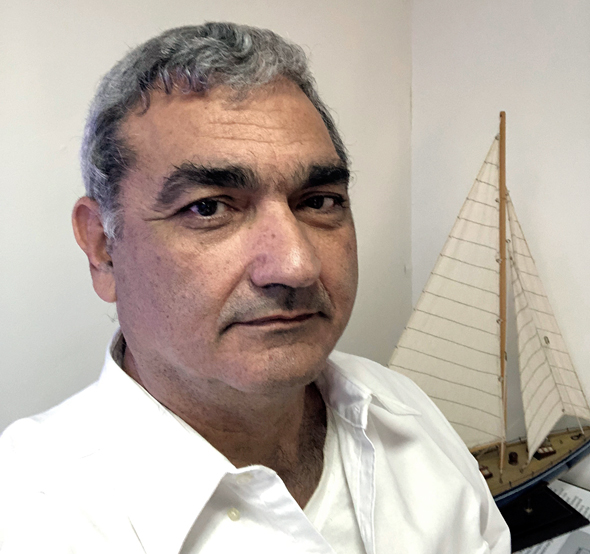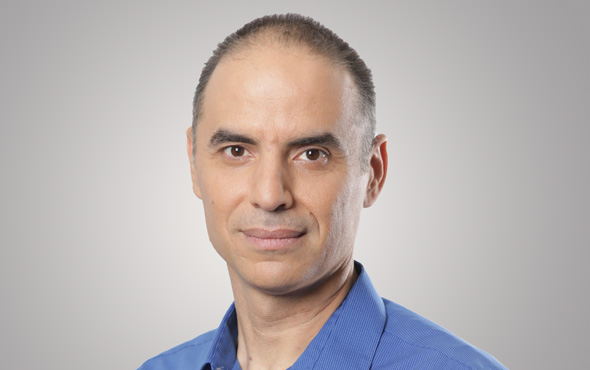5G Tech
Israeli companies leading global 5G revolution
There are currently over 25 Israeli companies working on 5G related tech, from giants like Intel to small early-stage startups
The dramatic upgrade in telecommunication capabilities provided by 5G, the fifth generation technology standard for cellular networks, will unleash a wide range of solutions that in many aspects will change life as we know it. In fact, it is set to bring to life what were once only science fiction fantasies, like autonomous vehicles, talking robots, and virtual reality.
 5G is coming. Photo: Shutterstock
5G is coming. Photo: Shutterstock There are currently over 25 Israeli companies working on 5G related tech, from giants like Intel to small early-stage startups.
One of the veterans of the industry in Israel is Zion Hadad, who now heads startup RunEL NGMT Ltd. More than 20 years ago, Hadad was one of the people who pioneered the Orthogonal Frequency-Division Multiple Access (OFDMA) scheme, which is part of the physical layer of 5G, as well as 4G and previous cellular technology. Without getting too technical, OFDMA is a digital modulation scheme that enables tapping into smaller segments of the frequency spectrum with timed functionality. Hadad went on to raise around $20 million for his company Runcom, which after several successful years suffered a painful setback, mainly as a result of the 2008 crash and new technological developments. It still exists but was forced to cease operations. With the interest in 5G growing, Hadad decided to set up RunEL in 2015. RunEL is currently developing a series of processors for 5G base stations that streamline the connectivity with different devices.
5G is essentially composed of two main parts. There is the network's wireless system, the Radio Access Network (RAN), which is the way the device communicates with the base station, what frequencies it uses, and how fast it transfers data. The second part of the 5G network is the core network, which is used to keep the network operating efficiently, essentially enabling the more sophisticated usages of the network like machine-to-machine communication and cloud edge services.
"Our vision is that every subscriber will be able to reach 10 megabits a second at any time, which is the equivalent of several thousand gigabit a month," Hadad told CTech. "I created simulations and researched our infrastructure and found that there is hardly any need to add new antennas in order to upgrade Israel to 5G. There are already around 7,000-8,000 antennas in Israel and this infrastructure is in good enough shape to build on.”
 RunEL founder Zion Hadad. Photo: Courtesy
RunEL founder Zion Hadad. Photo: Courtesy 5G essentially operates on two spectrums: one is of 6 gigahertz (GHz) and lower, and the second is brand new and runs between 28-GHz to 60-GHz. These frequencies are also known as millimeter waves, which due to their physical nature behave differently than the lower frequency waves. They require a far greater investment in infrastructure as their antennas only cover an area of 100 meters. According to Hadad, Israel doesn't need millimeter waves at this stage and the Ministry of Communications has yet to open a tender for these frequencies.
Some of RunEL's intellectual property is integrated into products developed by Intel, which has identified 5G as a major growth opportunity. “As the industry makes the transition to 5G, we continue to see network infrastructure as the most significant opportunity, representing a $25 billion silicon opportunity by 2023,” said Navin Shenoy, executive vice president and general manager of the Data Platforms Group at Intel when the company announced its portfolio for 5G network infrastructure back in February.
- U.S. or China: Who will end up winning the 5G Cold War?
- When it comes to 5G, colorful conspiracies have trumped boring old facts
- 5G is driving the world crazy, but what is it really?
"Intel is very involved in 5G in two aspects. One is at the client level, in laptops and mobile devices where we provide the cellular and WiFi solutions that enable these upgrades. Many of these solutions are developed by teams here in Israel in collaboration with other teams worldwide," Ilan Bressler, general manager, wireless communication solutions, client compute group at Intel, told CTech. "The second aspect that Intel is involved in is the core network. This is essentially a new generation of servers and base stations. The 5G core network is moving pieces of the data center to be part of the network, giving many more capabilities to enable quality of service, responsiveness and network manageability, enabling end-to-end usages that were not possible before. Intel is leading the way here in both computing and communication solutions. There are many new opportunities here, both from a technological standpoint and a use-case standpoint that are also very promising from a business perspective."
 Ilan Bressler, GM, wireless communication solutions, client compute group, Intel. Photo: Intel
Ilan Bressler, GM, wireless communication solutions, client compute group, Intel. Photo: Intel Israeli companies offer a wide range of 5G products like in-premises mobile cloud solutions, data analytics for communications and media service providers, and telecom access solutions and products. TetaVi Ltd., for example, is aiming to disrupt the entertainment sector by developing a method and system to generate high-quality free-viewpoint video content for sports, broadcast, and virtual-reality applications. In healthcare, Binah AI Ltd.'s technology enables the extraction of a large set of vital signs and mental stress measurements based on the analysis of a video taken with any device equipped with a camera. NoTraffic Ltd. is an autonomous traffic management platform designed for smart cities, looking to address traffic challenges while unlocking mobility benefits for cities.
Another company counting on 5G for future success is Saguna Networks Ltd. Saguna underwent a strategic shift six years ago when it started developing edge computing products. Edge computing improves response times and saves bandwidth by essentially bringing computation and data storage closer to the location where it is needed. Saguna decided to pivot after understanding that there is an ever-increasing demand on networks coming from IoT devices, social gaming, AR (Augmented Reality), VR (Virtual Reality), as well as autonomous vehicles, robots, and drones.
"All of these new developments require very high reliability on the one hand, as well as very low latency," Saguna CEO, Ido Gur, told CTech. "So imagine you need to process something, but the computing engine doing that is on an Amazon, Google or Microsoft cloud, which might not even be in the same country, and by the time the job gets done it could take hundreds of milliseconds, which for certain applications is far too long and very problematic.
"Many applications require AI in order to reach a good level of decision making and often that AI engine is located remotely. For example, a camera that analyzes many different parameters. The analysis of the picture might require a lot of computing and the cameras can't do it themselves so they send it to a ‘central brain’ which does it for them before sending the info back. That requires a lot of broadband and if there is a big distance between the two and there is a delay it is almost impossible to achieve. These issues held back a lot of technological developments."
 Saguna CEO Ido Gur. Photo: Courtesy
Saguna CEO Ido Gur. Photo: Courtesy Gur believes that the ongoing progress being made in 5G and cloud computing will help unlock many promising technologies. "The advantages of edge computing and 5G are very similar, with both being a lot more reliable and having low latency. 5G and edge computing complement each other and are evolving together," said Gur. "The biggest mobile company in South Korea, SK Telecom, has purchased our systems and they are designating it for the end customer, which is unusual as our product is usually used for enterprise purposes. But they decided to use our platform for gamers who without our application wouldn't be able to play their online games. This is, of course, all done on 5G. So essentially 5G together with edge computing opens the door to a new world of applications that require high speed, high reliability, and low latency."
Gur is optimistic Saguna, which employs around 15 people based out of Yokne'am Illit, is well placed to benefit from 5G's momentum. "5G took quite a few years to enter the market as 4G was working pretty well. So there are a lot of companies sitting on the fence waiting for the change to happen before making the move. We are now feeling traffic increasing in that direction and that the world is waking up to 5G. Edge computing is also gaining traction and it is exciting that the two are happening together," added Gur.
RunEL also employs around 15 people, with its offices located in Rishon Lezion. Hadad provided the initial funding, with the company receiving grants totaling around $5 million from the Israel Innovation Authority, the EU's Horizon 2020 research and innovation program, and others.
"What makes our product unique are two particular features. The first is that we provide a very low latency of less than half a millisecond compared to a few milliseconds by our competition," Israel Koffman, co-founder, and executive VP at RunEL told CTech. "This is a feature that is much needed in autonomous vehicles, drones, robots, AR, VR and online gaming. This makes us 100 times faster than 4G and several times faster than our rivals. The second unique aspect is that due to our deep knowledge in OFDMA, we can measure a device's location with an accuracy of centimeters, and not by using GPS or any other technology, but simply by measuring time. We can measure the distance between the device and the base station down to nanoseconds and that allows us to identify the precise location of the device down to whether it is in your right or left pocket. The tools being used today, in comparison, are accurate to within tens of meters."
 RunEL co-founder Israel Koffman. Photo: Courtesy
RunEL co-founder Israel Koffman. Photo: Courtesy Koffman said RunEL expects its processors to be ready in the second half of 2020 and spoke of the market the company is targeting.
"On the one hand, we are competing with giants like Qualcomm and especially Intel. Intel provides different solutions and wants to ultimately sell its servers for the core network. Our intellectual property is also included in Intel's processors, so we are complimenting them more than competing with them," explained Koffman. "We believe we have an advantage in the new market of small cells and that is where we have the best chance to succeed. For example, if Amazon wants coverage for its warehouse that will allow its autonomous robots to work accurately and efficiently I think they would prefer to use our products in their base station. We have a roadmap according to which we hope to reach sales of hundreds of millions of dollars within
3-4 years. We are mainly targeting the small cells market. In 4G, this market wasn't so successful because the base stations provided good coverage. But with the higher frequencies used in 5G there is a need for a broader layout of stations, which makes small cells a must. You will need a station in every office as walls block high frequencies coming from the base station located, for example, in a building next to you. We are expecting the small cells market to be 100 times bigger than it was with 4G and we are hoping to succeed there."



